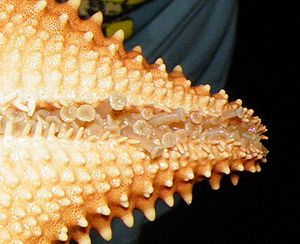Tube feet facts for kids
Tube feet are tiny, flexible tubes found on the underside of sea creatures like starfish, sea urchins, and sea cucumbers. These amazing parts are a key part of a special system called the water vascular system, which helps these animals live and move in the ocean.
How Tube Feet Work
Tube feet help these animals do many important things. They use them to move around, find and eat food, and even to breathe! Imagine having hundreds of tiny suction cups that can help you walk, grab things, and take in oxygen.
These little tubes work using water pressure, a bit like how a hydraulic lift works. Each tube foot can fill with water, making it stiff and long. Then, it can attach to a surface using a small suction cup at its tip. When the water is pushed out, the tube foot becomes soft and short again. This push and pull of water allows the animal to move slowly but surely across the ocean floor or even up rocks.
If a starfish accidentally flips over, it can use its tube feet to quickly turn itself back upright. It just attaches some tube feet to a solid surface and pulls itself over!
Tube Feet and Feeding
One of the most interesting ways starfish use their tube feet is for hunting. Starfish love to eat bivalves, which are creatures like clams and mussels that live inside two strong shells. These shells are held tightly shut by powerful muscles.
A starfish will grab onto both sides of a bivalve's shell with its many tube feet. Then, it starts to pull steadily. Even though the bivalve's muscles are strong, the starfish can keep pulling for a very long time, much longer than the bivalve can keep its shell closed.
After about ten minutes, the bivalve's muscles get tired, and the shell opens just a tiny bit. This small gap, sometimes as narrow as a hair, is all the starfish needs! It then pushes its stomach out of its mouth and slips it right inside the bivalve's shell. The starfish then digests the soft body of the bivalve right inside its own shell, absorbing all the nutrients. This part of the meal can take a couple of days.
Images for kids
-
Sea urchin tube feet extended past the spines.
-
Collector urchins (Tripneustes gratilla) have elongated podia.
-
Oral face of a sunflower sea star, Pycnopodia helianthoides.
-
Close-up on a P. helianthoides.











